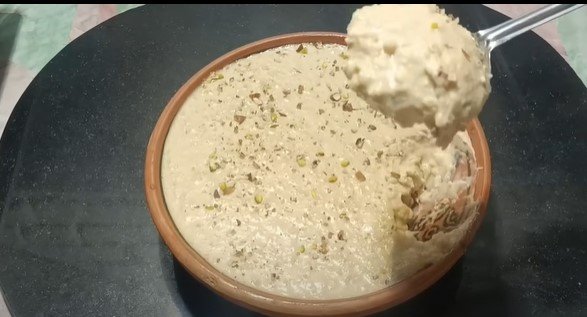As the holy month of Ramadan approaches, Muslims around the world prepare for a time of spiritual reflection, community, and of course, delicious food. The iftar meal, which breaks the daily fast, is a cherished moment that brings families and friends together. What better way to sweeten your iftar spread than with a creamy, aromatic bowl of Peshawar Qissa Khwani kheer? This traditional Pakistani dessert, known for its rich flavor and velvety texture, is typically associated with special occasions. However, with our budget-friendly pressure cooker recipe, you can enjoy this luxurious treat throughout Ramadan without straining your wallet.
The Significance of Desserts in Ramadan
Before we dive into the recipe, let’s take a moment to appreciate the role of desserts in Ramadan. Sweets have always held a special place in Islamic culture, especially during this holy month. They’re not just a way to replenish energy after a long day of fasting; they also symbolize the sweetness of faith and the joy of breaking fast with loved ones. Kheer, with its comforting warmth and rich flavors, embodies the spirit of Ramadan hospitality and celebration.
Why Choose Peshawar Qissa Khwani Kheer for Iftar?
Peshawar’s Qissa Khwani Bazaar is famous for its storytellers and its delectable cuisine. The kheer from this region is particularly renowned for its creamy texture and balanced sweetness. By recreating this recipe at home, you’re not just preparing a dessert; you’re continuing a centuries-old tradition of sharing stories and flavors.
This version of kheer is perfect for Ramadan for several reasons:
- It’s easy to prepare in advance, saving you time during the busy iftar hours.
- The recipe is scalable, allowing you to make larger batches for family gatherings or mosque donations.
- Its rich nutritional profile, including carbohydrates from rice and protein from milk, makes it an excellent energy booster after a day of fasting.
- The aromatic spices used in the recipe can help stimulate appetite, which is beneficial when breaking the fast.
Now, let’s get into the details of how you can bring this Peshawar specialty to your Ramadan table.
Ingredients: The Building Blocks of Flavor
To create this delightful dessert, you’ll need:
- 150g broken basmati rice
- 1.5 liters of full-fat milk (buffalo milk preferred, but cow’s milk works too)
- 200g sugar
- 12-13 pieces of bread rusks (about 50g)
- 4 tablespoons milk powder
- 3-4 green cardamom pods, crushed
- Chopped nuts for garnish (pistachios and almonds)
Each ingredient plays a crucial role in creating the authentic taste and texture of Peshawar Qissa Khwani kheer:
- Broken basmati rice: This type of rice breaks down easily, contributing to the creamy consistency of the kheer.
- Full-fat milk: The high fat content is essential for achieving the rich, luxurious texture that this dessert is known for.
- Sugar: While providing sweetness, it also helps in thickening the kheer.
- Bread rusks: An unconventional ingredient that adds body and a subtle flavor to the dessert.
- Milk powder: This intensifies the milk flavor and helps create a creamier texture.
- Cardamom: The aromatic spice that gives the kheer its characteristic flavor.
- Nuts: For garnish, adding a delightful crunch and nutty flavor to each spoonful.
The Cooking Process: Pressure Cooker Magic
Step 1: Preparing the Rice
- Start by washing the broken basmati rice thoroughly. This removes excess starch and prevents the kheer from becoming too gluey.
- Soak the rice for at least an hour before cooking. This step is crucial as it allows the rice grains to absorb water, resulting in a softer texture that will blend seamlessly into the kheer.
Step 2: Creating the Base
- In a blender, combine the bread rusks, 2 cups of milk, milk powder, and crushed cardamom.
- Blend until you achieve a smooth consistency. This mixture forms the base of your kheer, providing body and flavor.
Step 3: Cooking the Rice
- Add the soaked rice, 3 cups of water, and 1 cup of milk to the pressure cooker.
- Cook on medium heat for 10 minutes or until the rice is soft. The pressure cooker significantly reduces cooking time, making this recipe perfect for busy Ramadan evenings.
Step 4: Caramelizing Sugar (Optional)
- In a separate pan, caramelize 5 tablespoons of sugar with a little water until it turns golden brown.
- Set this aside to add later. This step, while optional, adds depth to the color and flavor of your kheer.
Step 5: Bringing It All Together
- Add the blended mixture to the cooked rice in the pressure cooker.
- Pour in the remaining milk and sugar.
- Cook on medium-low heat for about 20 minutes, stirring constantly. This constant stirring is key to achieving the creamy consistency that Peshawar Qissa Khwani kheer is famous for.
- Add the caramelized sugar (if using) and mix well.
Step 6: Final Touches
- Once the kheer has thickened to your desired consistency, turn off the heat.
- Stir in half of the chopped nuts, reserving the rest for garnish.
- Pour into serving dishes and sprinkle the remaining nuts on top.
Tips for Perfect Peshawar Qissa Khwani Kheer
To ensure your kheer turns out perfectly every time, keep these tips in mind:
- Always use low to medium heat to prevent burning. Patience is key when making kheer.
- Stir continuously to achieve a creamy texture. This prevents the milk from sticking to the bottom of the pot and helps incorporate air, making the kheer lighter.
- Let the kheer cool at room temperature before refrigerating. This gradual cooling helps preserve the texture.
- Chill for 2-3 hours before serving for the best flavor and consistency. The flavors meld and intensify as the kheer cools.
Serving Suggestions for Ramadan
Kheer is versatile and can be served in various ways during Ramadan:
- As a sweet ending to your iftar meal: Serve it chilled in individual bowls, garnished with extra nuts and a sprinkle of cardamom powder.
- As part of a dessert spread: Pair it with other traditional Ramadan sweets like zarda (sweet rice) or sheer khurma for a diverse dessert offering.
- For suhoor (pre-dawn meal): A small serving of kheer can provide a sweet energy boost to start your fasting day.
- As a gift: Package it in decorative containers to share with neighbors and friends, embodying the spirit of community during Ramadan.
The Health Benefits of Kheer During Ramadan
While kheer is undoubtedly a treat, it also offers some nutritional benefits that are particularly valuable during Ramadan:
- Energy boost: The combination of carbohydrates from rice and sugars provides quick energy, helpful when breaking the fast.
- Hydration: The high liquid content helps replenish fluids lost during fasting.
- Protein: Milk and nuts contribute protein, which is essential for maintaining muscle mass during the fasting month.
- Calcium: The dairy ingredients provide calcium, supporting bone health.
- Easy digestion: The soft texture of kheer makes it easy on the stomach, especially important when breaking a long fast.
Adapting the Recipe for Dietary Needs
This Peshawar Qissa Khwani kheer recipe can be adapted to suit various dietary requirements:
- For a lactose-free version, substitute dairy milk with almond or coconut milk.
- To reduce sugar content, use a natural sweetener like stevia or reduce the amount of sugar.
- For a gluten-free option, omit the bread rusks and increase the rice quantity slightly.
Kheer in Islamic Tradition
Milk-based desserts like kheer have a special place in Islamic tradition. The Quran mentions rivers of milk in Paradise, symbolizing purity and nourishment. By preparing and sharing kheer during Ramadan, we connect with this spiritual symbolism while enjoying a delicious treat.
Conclusion: A Sweet Tradition for Ramadan
This pressure cooker version of Peshawar Qissa Khwani kheer brings a taste of tradition to your Ramadan table without the need for expensive ingredients or time-consuming preparation. It’s a testament to how we can honor our culinary heritage while adapting to modern lifestyles.
As you gather with family and friends to break your fast this Ramadan, let the creamy, aromatic kheer be a reminder of the sweetness of faith and community. Whether you’re serving it to your immediate family or sharing it with your entire neighborhood, this dessert is sure to bring smiles and satisfaction.
Remember, the true spirit of Ramadan lies not just in the food we eat, but in the love and intention with which we prepare and share it. As you stir your pot of kheer, let it be a moment of reflection and gratitude for the blessings in your life.
From all of us to you, Ramadan Kareem! May your fasts be easy, your iftars delightful, and your kheer always creamy and sweet.



